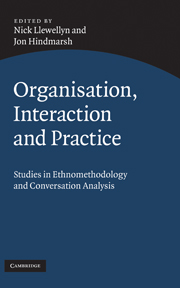Book contents
- Frontmatter
- Contents
- List of contributors
- Preface
- Part I Orientations
- Part II Studies
- 3 A kind of governance: rules, time and psychology in organisations
- 4 On the reflexivity between setting and practice: the ‘recruitment interview’
- 5 The situated production of stories
- 6 Orders of bidding: organising participation in auctions of fine art and antiques
- 7 Some major organisational consequences of some ‘minor’, organised conduct: evidence from a video analysis of pre-verbal service encounters in a showroom retail store
- 8 The work of the work order: document practice in face-to-face service encounters
- 9 The interactional accomplishment of a strategic plan
- 10 Peripherality, participation and communities of practice: examining the patient in dental training
- List of references
- Index
4 - On the reflexivity between setting and practice: the ‘recruitment interview’
Published online by Cambridge University Press: 20 May 2010
- Frontmatter
- Contents
- List of contributors
- Preface
- Part I Orientations
- Part II Studies
- 3 A kind of governance: rules, time and psychology in organisations
- 4 On the reflexivity between setting and practice: the ‘recruitment interview’
- 5 The situated production of stories
- 6 Orders of bidding: organising participation in auctions of fine art and antiques
- 7 Some major organisational consequences of some ‘minor’, organised conduct: evidence from a video analysis of pre-verbal service encounters in a showroom retail store
- 8 The work of the work order: document practice in face-to-face service encounters
- 9 The interactional accomplishment of a strategic plan
- 10 Peripherality, participation and communities of practice: examining the patient in dental training
- List of references
- Index
Summary
Introduction
In recent years there has been a much discussed ‘turn to practice’ within organisation studies (see Jarzabkowski 2004; Boczkowski and Orlikowski 2004; Alby and Zucchermaglio 2006; Nicolini 2007). This has raised questions about how to theorise and empirically access practice, in ways that reveal the interplay between knowledge and ordinary work activity (Gherardi 2001: 132–5; Gherardi and Nicolini 2002b). Such questions and interests have simultaneously, though largely independently, been pursued in a body of ethnomethodologically informed research, which is also committed to a ‘practice-based theory of knowledge and action’ (C. Goodwin 1994: 606). Such themes are apparent in studies of ‘situated actions’ (see Suchman 1987) and the ‘choreography’ of ordinary work practice (J. Whalen, Whalen and Henderson 2002). A key concern of ‘workplace studies’ (see Luff, Hindmarsh and Heath 2000; Heath, Luff and Sanchez Svensson 2002) has also been the interplay between knowledge, learning and ordinary work practice (see Hindmarsh and Pilnick 2007). Despite common interests, the points of connection between these literatures have been minimal.
The present chapter explores one way in which ethnomethodologically informed research might inform the ‘practice turn’ within organisation studies, via an illustrative study of interaction during graduate recruitment interviews. The chapter explores how the practice of recruitment is a product of, and simultaneously a resource for, ordinary interaction during job interviews. What Graham Button calls ‘interview orthodoxy’ (Button 1992) is reproduced through interaction, but it simultaneously allows actors to resolve practical problems such as ‘what next’ and ‘why this now’ (Garfinkel 1967).
- Type
- Chapter
- Information
- Organisation, Interaction and PracticeStudies of Ethnomethodology and Conversation Analysis, pp. 74 - 95Publisher: Cambridge University PressPrint publication year: 2010
- 6
- Cited by

